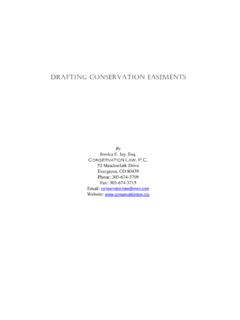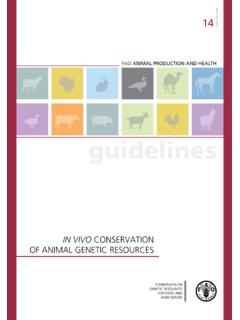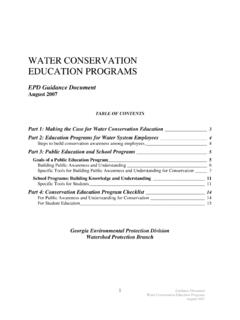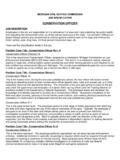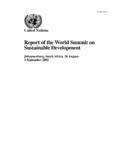Transcription of Voluntary guidelines for the conservation and sustainable ...
1 Voluntary guidelines for the conservation and sustainable Use of Crop Wild Relatives and Wild Food PlantsCrop wild relatives are potential sources of desirable traits for breeding well-adapted varieties while wild food plants constitute important components of the diets of many people worldwide. Unfortunately, their natural wild habitats are increasingly under threat from both human activities and natural disasters. Habitat loss has a direct, negative impact on the diversity of these valuable resources. These guidelines , intended as reference materials for preparing a National Plan for the conservation and sustainable Use of Crop Wild Relatives and Wild Food Plants, will contribute to stemming this continuing loss in diversity. The guidelines are therefore a useful tool for development practitioners, researchers, students and policy-makers who work on the conservation and sustainable use of these valuable guidelines for the conservation and sustainable Use of Crop Wild Relatives and Wild Food PlantsFAOI7788EN/1 978-92-5-109919-39789251099193 Voluntary guidelines for the conservation and sustainable Use of Crop Wild Relatives and Wild Food PlantsFood and Agriculture Organization of the United Nations Rome, 2017 Voluntary guidelines FOR THE conservation AND sustainable USE OF CROP WILD RELATIVES AND WILD FOOD PLANTSThe designations employed and the presentation of material in this informationproduct do not imply the expression of any opinion whatsoever on the part of theFood and Agriculture Organization of the United Nations (FAO)
2 Concerning the legalor development status of any country, territory, city or area or of its authorities, orconcerning the delimitation of its frontiers or boundaries. The mention of specificcompanies or products of manufacturers, whether or not these have been patented,does not imply that these have been endorsed or recommended by FAO in preferenceto others of a similar nature that are not views expressed in this information product are those of the author(s) and do notnecessarily reflect the views or policies of 978-92-5-109919-3 FAO, 2017 FAO encourages the use, reproduction and dissemination of material in this informationproduct. Except where otherwise indicated, material may be copied, downloaded andprinted for private study, research and teaching purposes, or for use in non-commercialproducts or services, provided that appropriate acknowledgement of FAO as the sourceand copyright holder is given and that FAO s endorsement of users views, products orservices is not implied in any requests for translation and adaptation rights, and for resale and other commercialuse rights should be made via or addressed information products are available on the FAO website ( )and can be purchased through featured on cover (from left to right, beginning with the top row): Alaska wild berries USFWST eosinte Jalisco (Zea mays ssp.)
3 Parviglumis) CC/ MbhuffordWild sweet potato (Ipomoea trifida) CC/ B. HammelWild anona fruit (Anona senegalensis) FAO/ R. FaiduttiWild artichoke (Cynara cardunculus L. subsp. sylvestris) FAO/ A. NooraniMountain papaya (Vasconcellea pubescens) CC/ M. HermannZea diploperennis (Teosinte) M. LavinTriticum columna Armenian Agrarian University/ A. MelikyanWild peanut (Arachis spp.) Bioversity International/ A. LaneDioscorea sp. Ng uni DicksonWild bean (Phaseolus polystachios) CC/ FritzflohrreynoldsWild barley (Hordeum spontaneum) Bioversity International/ I. ThormannWild blueberries CC/ dennisflarsenWild sunflower CC/ of Acronyms ..ixExecutive INTRODUCTION ..12. LEADERSHIP AND UNDERSTANDING THE COUNTRY PLANNING CROP WILD RELATIVES AND WILD FOOD PLANT WRITING THE STRATEGIC PLAN ..476. IMPLEMENTING STRATEGIC MONITORING CROP WILD RELATIVES AND WILD FOOD PLANT DIVERSITY, AND INFORMATION MANAGEMENT ..718.
4 CAPACITY 1 ..85iiiContentsForewordCrop wild relatives thrive in their natural habitats without human intervention. In fact, they are continuously evolving adaptive characteristics that enable them to cope with changing environmental conditions. Therefore, they are a rich reservoir of novel traits and genes that can be used to develop crop varieties that are adapted to climate change. There is ample evidence of their successful use in crop food plants, on the other hand, constitute important components of the diets of many people across the globe. Though undomesticated, they are rich sources of very important micronutrients, which, sadly, are lacking in the main staple crops that people are increasingly relying on for nourishment. Wild food plants could therefore play critically important roles in combatting malnutrition. As they exist in the wild, they are also continuously evolving adaptive wild relatives and wild food plants share one thing in common: their habitats.
5 These natural wild habitats are increasingly under threat from both human activities and natural disasters, implying that the diversity of both crop wild relatives and wild food plants are being continuously eroded. In fact, many could become extinct if the current level of neglect is not s ongoing support to countries on the conservation and sustainable use of these resources is in accord with several international instruments and agreements. These include the Convention on Biological Diversity, the International Treaty on Plant Genetic Resources for Food and Agriculture, the Second Global Plan of Action for Plant Genetic Resources for Food and Agriculture and, most recently, the sustainable Development Goals. As a latest example of its support to countries, FAO has developed the Voluntary guidelines for the conservation and sustainable Use of Crop Wild Relatives and Wild Food guidelines FOR THE conservation AND sustainable USE OF CROP WILD RELATIVES AND WILD FOOD PLANTSE ndorsed by FAO s Commission for Genetic Resources for Food and Agriculture, the guidelines are recommended for use by governments in the development of National Plans for the conservation and sustainable Use of Crop Wild Relatives and Wild Food Plants.
6 Development practitioners, researchers, students and policy-makers that are interested in these themes will also find the guidelines and the well-researched reference resources Wang Assistant Director-GeneralAgriculture and Consumer Protection DepartmentFood and Agriculture Organization of the United NationsviAcknowledgementsThese guidelines were produced under the guidance of and were endorsed by FAO s Commission on Genetic Resources for Food and Agriculture (Commission). FAO s Plant Production and Protection Division adapted the guidelines from the Resource Book for Preparation of National conservation Plans for Crop Wild Relatives and Landraces, an earlier FAO-commissioned study undertaken by the University of Birmingham, United Kingdom. The publication of these guidelines was made possible by the contributions of many individuals. ContributorsLinn Borgen Nilsen1, Nigel Maxted2, Chikelu Mba1, Ehsan Dulloo1, Kakoli Ghosh1, Joana Magos Brehm2, Shelagh Kell2, Stefano Diulgheroff1, Arshiya Noorani1 and Bonnie Furman1.
7 (1 FAO; 2 University of Birmingham)Inputs were provided by the Members of the Commission and several individuals, including Nadiya Al-Saadi, Achille Ephrem Assogbadjo, Tania Carolina Camacho-Villa, Edwin Chiwona, Jure op, S nia Dias, Maria Cristina Duarte, Jan Engels, Dionysia Fasoula, Heli Fitzgerald, Maarit Heinonen, Vojtech Holubec, Marina Hovhannisyan, Helena Korpelainen, Juozas Labokas, Baorong Lu, Pedro Mendes Moreira, Valeria Negri, Juan Jos Ruiz Martinez, Mar a Luisa Rubio-Teso, Suzanne Sharrock, Tamara Smekalova, Tsevetelina Stoilova, Imke Thormann, Renzo Torricelli, Jos Valls, Rudolf V gel and John Wiersema. Design and layoutAlessandro Mannocchi and Diana Guti rrez M of AcronymsCBD Convention on Biological DiversityCSO Civil Society OrganizationCWR Crop Wild Relative(s)FAO Food and Agriculture Organization of the United NationsFIGS Focused Identification of Germplasm StrategyGIS Geographical Information SystemGPA Global Plan of ActionGPS Global Positioning SystemGSPC Global Strategy for Plant ConservationInternational Treaty International Treaty on Plant Genetic Resources for Food and AgricultureIUCN International Union for conservation of NatureixxVOLUNTARY guidelines FOR THE conservation AND sustainable USE OF CROP WILD RELATIVES AND WILD FOOD PLANTSN agoya Protocol Nagoya Protocol on Access to Genetic Resources and the Fair and Equitable Sharing of Benefits Arising from their Utilization [protocol to the Convention on Biological Diversity]
8 National CWR Plan National Plan for the conservation and sustainable Use of Crop Wild Relatives and Wild Food PlantsNBSAP National Biodiversity Strategy and Action PlanNGO Non-Governmental OrganizationNUS Neglected and Underutilized SpeciesPA Protected AreaPES Payment for Environmental ServicesPGR(FA) Plant Genetic Resources (for Food and Agriculture)PIC Prior Informed ConsentSIS Species Information Service [of IUCN]SNP Single Nucleotide PolymorphismSSR Single Sequence Repeat(s)TDGW Taxonomic Databases Working Group developing Biodiversity Information StandardsxxiExecutive SummaryCrop wild relatives are potential sources of traits for crop improvement, especially for developing varieties tolerant to biotic and abiotic stresses. Wild food plants, on the other hand, constitute important components of the diets of many people. Both types of plant genetic resources for food and agriculture continue to evolve adaptive traits in their natural habitats.
9 However, a combination of human activities and natural disasters is eroding this diversity, and could ultimately lead to extinctions. The reality of these threats requires greater attention to the conservation and sustainable use of these plant genetic resources. The Food and Agriculture Organization of the United Nations, under the guidance of its Commission on Genetic Resources for Food and Agriculture, therefore prepared the Voluntary guidelines for National Level conservation of Crop Wild Relatives and Wild Food Plants ( guidelines ). The guidelines are intended primarily for use by governments to develop a national plan for the conservation and sustainable use of crop wild relatives and wild food plants. The guidelines are organized into eight chapters. The first two chapters provide context and deal with the requisites, what needs to be in place for developing a national plan. Chapter 1, Introduction, presents overviews of the importance of these resources, the threats that they face and the relevant global policy instruments.
10 These serve as the backdrop against which the case is made for countries to develop viable national plans. Chapter 2, Leadership and Stakeholders, underscores the importance of a coordinating mechanism and identifies the important constituencies both for the development of the plan and, as importantly, its implementation. Voluntary guidelines FOR THE conservation AND sustainable USE OF CROP WILD RELATIVES AND WILD FOOD PLANTSxiiChapter 3, Understanding the National Context, aims at assisting in the generation of the evidence base that will underpin the national plan. It provides guidance on benchmarking the relevant prevailing policy and legal systems as well as the status of the conservation and use of these resources in the country. It also addresses the possible scope of the envisaged national plan in terms of geographical and taxa coverages and linkages to other complementary activities, including genebanks and sustainable use.










